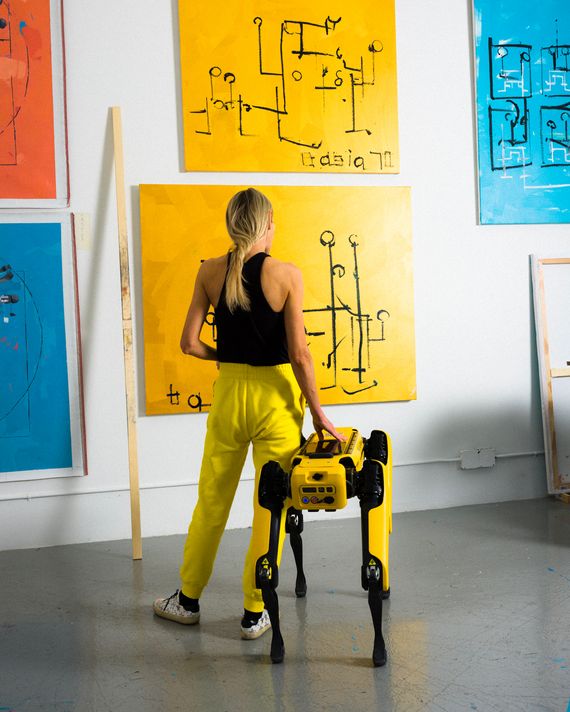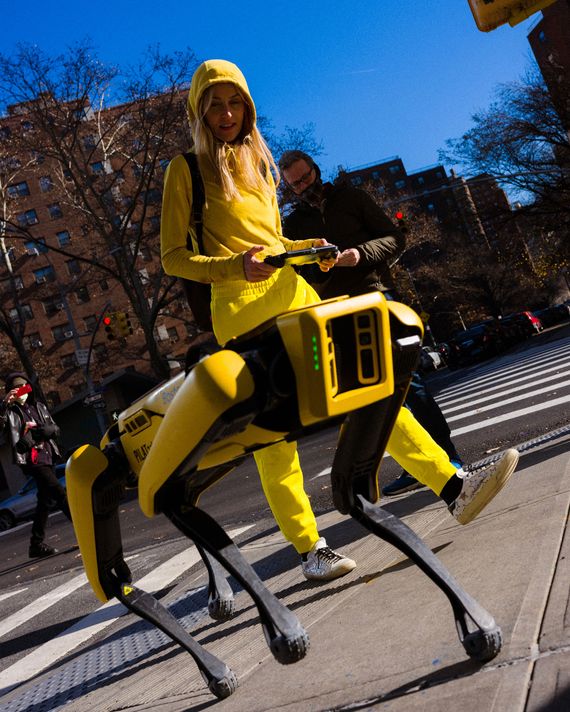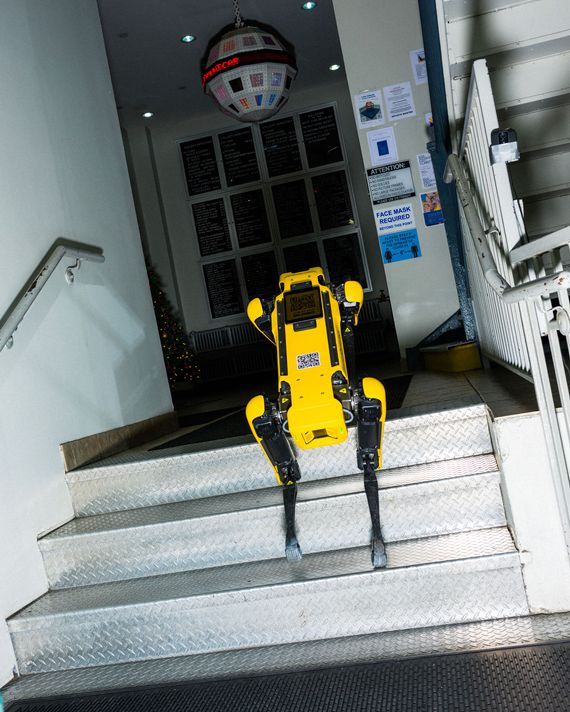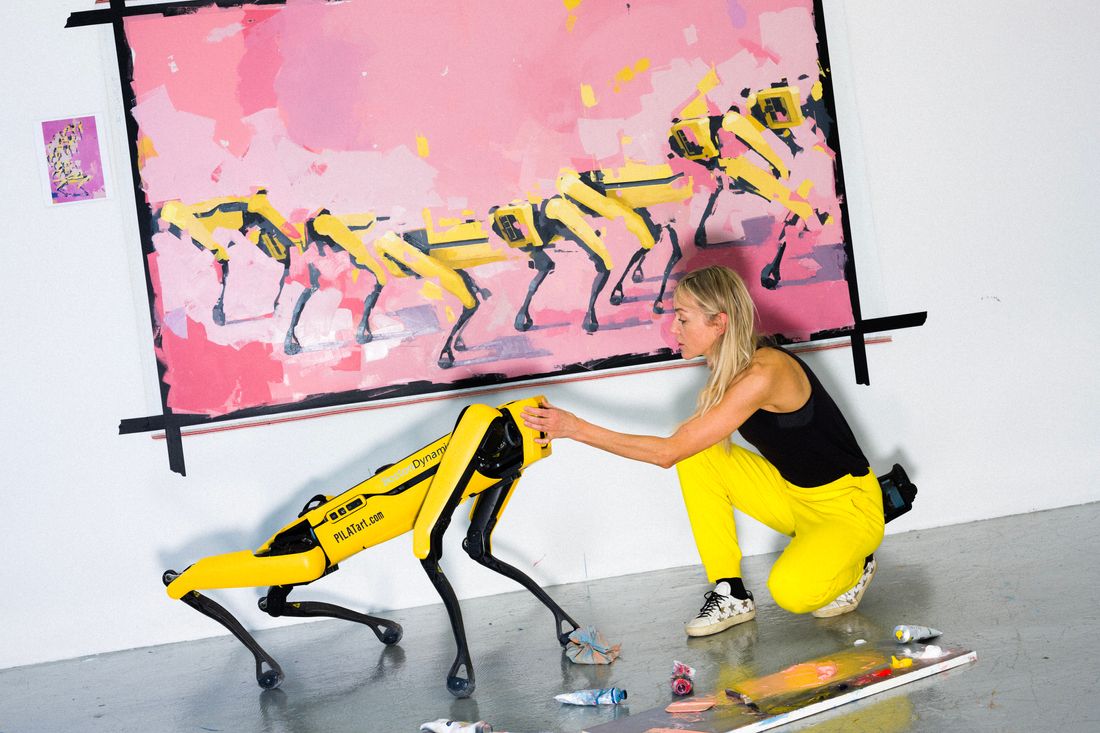
When I meet Agnieszka Pilat, a pixie-ish Polish émigré who has become the court painter of the potentates of Silicon Valley, she has just returned from Necker Island, the private Caribbean domain of Richard Branson. “I’m always the poorest person in the room” at places like that, she says with a laugh, curling her paint-flecked Yves Saint Laurent sneakers beneath her on the couch as she absentmindedly twists and untwists her hair. We’ve met up in her Chelsea studio, in which paintings of robotic limbs in repose dot the concrete walls. She has another studio in San Francisco. In each, she kennels a duplicate Spot, her 70-pound emergency-yellow cybernetic dog, muse, studio assistant (it paints, too), and, in some sense, protector, both on loan to her from Boston Dynamics, where she was once artist in residence.
Despite her Chelsea digs near the blue-chip Gagosians and Zwirners, Pilat does not have much of a reputation in the mainstream art world. She hasn’t been sought after in big biennials and isn’t owned by major museums, and the critics mostly ignore her. But the 48-year-old is beloved by a group of very well-off men — her collectors are mostly men — who don’t participate much in the art world and are likely turned off by its snobberies and sanctimonies. Instead, she puts Silicon Valley’s Ayn Rand–ian, futurist ideologies into paint. Her work can even be found, if you look carefully, decorating the sets of the new Matrix movie. And she’s definitely not being ironic about any of it.
“I am always that kid who grew up in Poland, in communism,” she says, “and for me, America and American aristocracy, which you guys don’t have — aristocracy like we have in Europe — the aristocracy here is the industry. So I think it’s important to give moral tribute to people in technology.” She is merrily in service to the tech nomenklatura at a time when much of the country has come to despise its members for the forces they have unleashed on society and for their obscene levels of wealth.
Pilat describes Craig McCaw, the press-averse telecommunications billionaire who also purchased his own island, as her top patron and “angel.” Another collector is John Krafcik, the former CEO of Waymo, Google’s self-driving-car unit. “Agnieszka’s work captures the magic of technology in a human, heroic way, and I think that helps us all better relate to it,” he says.
Krafcik introduced her to Yuri Milner, the reclusive Russian Israeli venture-capital billionaire. He has reportedly sprinkled Kremlin cash across Silicon Valley, where he spent $100 million on a nouveau château in Los Altos Hills. “He’s very hard to reach,” says Pilat. “Even his billionaire neighbors don’t know him.” Milner commissioned a painting of a piece of machinery found in self-driving cars. “He liked it,” she says, “but he’ll never hang the painting. He never displays real work. His whole house is like a digital Sistine Chapel, so you come into the house and it’s like a very opulent kind of cathedral-looking thing, and you think all these are paintings, but then everything changes. They’re huge, like, the whole ceiling — it’s all LEDs.” She says he’ll probably just keep the analog painting in storage.
What is it like dealing with these dudes? “They’re all egomaniacs,” she says, sounding thoroughly amused, even a bit affectionate. “They’re all wrapped up in themselves. It’s like talking to a fish out of water. They just don’t get it.”
Jaron Lanier, the Silicon Valley oracle who is often described as the godfather of virtual reality, sums up some of Pilat’s appeal to this cohort: “Successful techie guys love, love, love it when an attractive woman speaks their language, even if not everything she says is supportive. They find it irresistible. I don’t think what she actually says is uniformly positive, but people hear what they want to hear.”
Born in 1973, Pilat grew up during the bitter, last-gasp years of the Cold War. Her mother was a gym teacher and her father a pastry chef. “There was just overall misery around,” she recalls. “Everyone was poor and lived in these gray big blocks. It didn’t matter if you were a doctor or a janitor; you had everything the same.” The early-pandemic rush on two-ply made her nostalgic: “We never had toilet paper. It was, like, the biggest commodity.” She laughs. “I remember always standing in line as a little kid.” She hated the Soviets and longed for the West. In 1985, her “love for America” crystallized when Rocky Balboa knocked out Ivan Drago: “Everyone in Poland was like, ‘Yeahhhh!’ ”
Her father adapted well to the transition to capitalism and ended up owning many bakeries. The family grew prosperous. “I have a love for free enterprise and also value the value of hard work, because that’s how I grew up,” she says.
In 2004, as it happens, the year that what was then called TheFacebook was founded, she moved to San Francisco. Her first job was at Gold’s Gym, and she enrolled in the Academy of Art University to study illustration. She was technically skilled. One of her earliest commissions came from Paul Stein, a developer who built Airbnb’s headquarters. He wanted a portrait, not of a man but of a machine. Pilat did an oil painting of an old-school fire alarm that he loved. Soon word got around about her work. “The Bay Area is a very small crowd,” Pilat says. “When you meet one person, you meet many.” She found a patron in the tech executive Peter Hirshberg and scaled up from there. Pilat’s next collector was Steve Jurvetson, one of Silicon Valley’s top venture capitalists. Jurvetson was a board member of Tesla and currently sits on the board of SpaceX. “He’s the one who opened a lot of doors for me,” recalls Pilat.
And she genuinely admired what they were building, unlike many in San Francisco, which she calls “the center of liberal crazies”: “They don’t understand what collectivism leads to and what punishing someone just because they’re successful leads to.” A friend gave her a copy of Rand’s Atlas Shrugged. “I would not be the artist that I am without that book,” she says. “It gives you a moral right to develop your talent to the fullest and focus on what you think your talent is, and there’s an amazing power that comes from that, and I think America is a lot about that.” The brutality of Randian individualism, of the cult of the ego and its success, galvanized Pilat.
“In Silicon Valley, the book is very popular, of course,” she says. “But it’s quiet because if you are very wealthy, and white, and you like Atlas Shrugged — oh boy, you are a target.” She remembers being astonished at a dinner party when she discovered that Mark Pincus — the tech billionaire who co-founded the online-gaming company Zynga (Words With Friends, FarmVille, etc.) and made early investments in Facebook and Twitter — was, in Pilat’s telling, “all about Ayn Rand.” (Pincus says he has no recollection of this.) McCaw, Pilat says, “is so old and wealthy he doesn’t care at this point, but he’s famously a Republican, but he will not have a conversation about it because it’s just bad for business to be a Republican openly in those tech circles.”
Most recently, Pilat’s work was featured in the home of another tech-world legend: Neo. She was commissioned to do art for The Matrix Resurrections, and one of her paintings can be seen while Neo — er, Thomas Anderson — chews a piece of steak in his penthouse apartment. She thinks the Matrix is already coming true in the form of the metaverse. The masses will increasingly, and voluntarily, plug in. The waking world, real-life experiences, will be for only the one percent. “I think the divide is happening already,” she says, telling me about some real-estate deals going down in the metaverse that she knows about. “The myth of the metaverse, it’s happening in front of our eyes, and the pandemic only accelerated it.” Holy Wachowski!
“Machines are children of humanity,” she adds, waxing philosophical next to Spot. “So us, as good parents, stewards of machine technology and AI, it’s our obligation to culturally and morally have a relationship with them so they grow up to be good citizens.”
Spot’s movements are uncanny, those of a blood-and-guts pup. Up the stairs, down the hall, and lumbering around the corner it goes. Pilat can simply point to an object in the room with her controller and the dog will maneuver over and snatch it up with an outstretched claw.
Pilat sometimes affixes an oil stick to the dog’s claw to paint. “It’s like an extension of my arm,” she says. In other paintings, presumably made the archaic way — by hand — Spot is the subject, emulating works from art history. There it is posing for a reimagined version of Marcel Duchamp’s Nude Descending a Staircase (No. 2). And here are two roboclaws nearly touching, an homage to God and Adam on Michelangelo’s ceiling in the Sistine Chapel.
Dorka Keehn, a San Francisco–based art adviser and curator who was on the city’s arts commission, calls Pilat “an incredible painter” and says she’s “doing a service to the art world” by engaging the tech machers. “It’s very intimidating to go into a contemporary museum or gallery and look at some of this stuff if you don’t have any kind of context,” says Keehn, “and I think these titans don’t like not knowing. They’re used to being the smartest person in the room, and so they come in and who’s telling them? Some 20-something right out of art school.” But with Pilat, says Keehn, “they’ve got Spot the dog, which they can kind of geek out on the robotic aspect of it, but then she’s making these classical references to art, to the Renaissance.”
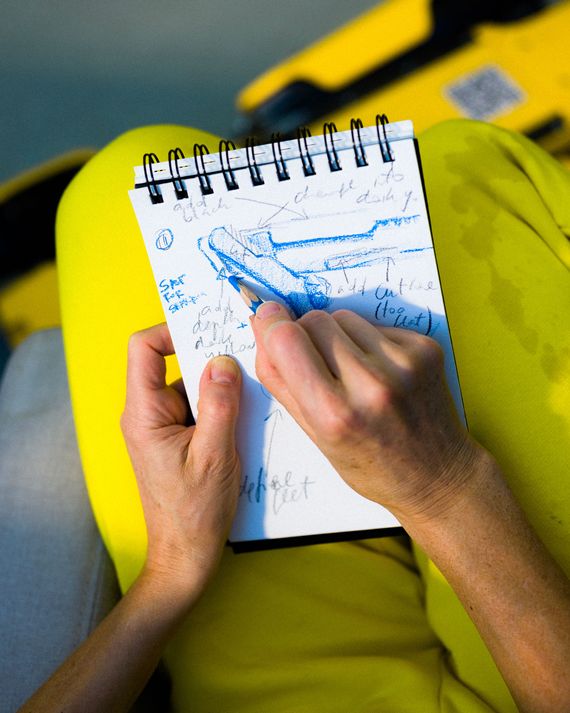
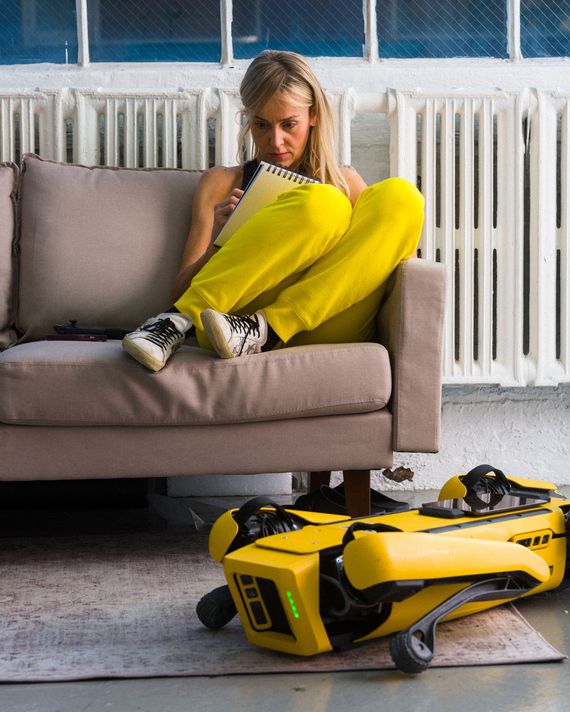
I ask this magazine’s art critic, Jerry Saltz, to take a look, but he is less convinced. “Derivative dreck,” he says. “Not one lick of life, originality, idea about surface, color, structure, or even subject matter. This work is and will be worth nothing — except to the Silicon rubes who see that other Silicon rubes like them bought art like this.” Not long ago, one painting Pilat made with Spot, B70 Self Portrait 02, sold for $31,500 at Sotheby’s as part of an auction presumably designed to appeal to Bay Area types called “Boundless Space … The Possibilities of Burning Man.”
“Not surprised about Jerry,” says Pilat when I tell her about his harsh review. “The art world is notoriously unhappy about tech billionaires, and I am singing their song. Unlike Diego Rivera, I won’t put Lenin in a commission paid by an industrialist.” (In 1932, Rivera was commissioned to do the main mural in the lobby of 30 Rockefeller Plaza. Rivera’s finished work, Man at the Crossroads, which contrasted socialism and capitalism with a worker at the center, got destroyed when he refused to remove a depiction of Lenin.)
In any case, it’s clear whose side she is on: the machine’s. She says about Spot, “I think this is going to be the first celebrity robot.” Indeed, Spot is Pixar-cute. But sinister, too. Remember that wild episode of Black Mirror with the killer dog-bot? When the NYPD got its paws on a version of Spot (its was blue) and sicced it on a crime scene in the Bronx, it was swiftly banished back to Boston.
“It was a horrible PR moment,” Pilat says. She believes the public must be properly introduced to the machines. We take the dog for a walk on West 26th Street. “I try to always dress in yellow so that you can easily see there’s a human with it,” she says. A woman approaches, trepidatious, to ask if it’s sold on Amazon. (It is not.) I post a video of Spot on my Instagram Story with a poll asking if the dog is “cute or scary”; 88 percent of respondents choose the latter. “KILL IT NOW BEFORE IT’S TOO LATE,” one replies.
“My patrons are actually the machines of the future,” Pilat says matter-of-factly. “I work for the machine, not the man. When you go to a museum today in Europe and you see a picture of an aristocrat or some rich guy, you think, Oh, these are my cultural ancestors. So in my mind, I see the museum of the future when an intelligent AI comes in and looks at this” — she gestures to a painting of Spot — “and, in the same way, is like, Oh, these are my ancestors.”
More on silicon valley
- The First AI Gadgets Are a Cautionary Tale
- Over Three Decades, Tech Obliterated Media
- The Vision Pro’s Biggest Problem Is Apple


